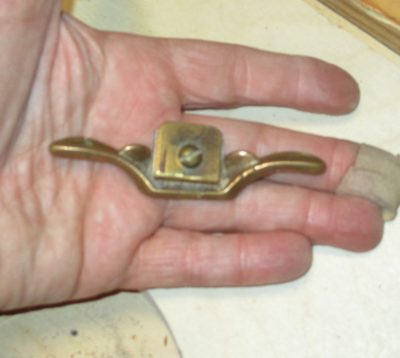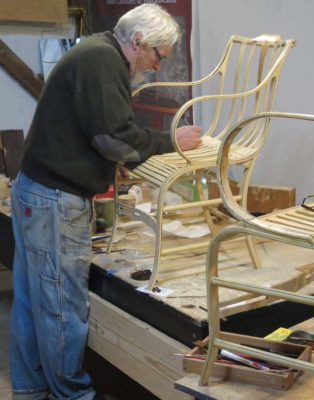Essential Planes – Near Miss #3

This third and final installment of “Near Miss” planes is an eccentric one revolving around the fact that I am not a chair maker. I am a Gragg Chair maker, a definite distinction. It might be a distinction without a difference, but it is a distinction. My only rationale for including this/these tools here is that indeed they are integral to that work but are probably not true panes. They are plane-ish. Yes, they have sharpened irons held inside a body but they are different enough to call their type into question. This/these tools are the micro spokeshave and its cousin, the drawspoon, sometimes called an inshave or scorp.
I was first introduce to the micro spokeshave in the foundry pattern shop when I started work there around 1978. At its core, when it came to the types of patterns we were often tasked with making, patternmaking was essentially no different than curvilinear sculpture. I was astounded the first time I watched the shop master John Kuzma lay waste to a glued-up stack-laminated helix that was to become the rib of a dredging cutterhead.

Almost hidden in his hand, this tiny tool soon had created a pile of shavings as the almost organic contour and surface took shape. While I had used “full sized” spokeshaves before, this little jewel was new to me and I have been a convert ever since. When I parted with the pattern shop in 1981 to marry Mrs. Barn and give college one final try — first college credits in 1972, tripe major degree finally in-hand in 1986 — John reluctantly bid me farewell (he could be an irascible sort but we got along famously; he came from the rough-and-tumble world of Cleveland factories and taught me obscenities and associated linguistic constructs that would make John McWhorter proud) he handed me as a farewell gift the micro spokeshave we had cast in the foundry. That tool remains one of my personal treasures.

The micro spokeshave we made in the foundry and John gave me as a farewell gift is the one in the upper right.
Flash forward to my first in-person encounter with a Gragg chair. Even underneath many coats of paint the processes and tools of Gragg were readily apparent, and a small spokeshave was integral to his work as well. Thus, when I started making replicas of his chair I was well equipped. Every curvilinear element of a Gragg chair is worked with this tool or one of its analogs (I own about two dozen micro spokeshaves and happily they are still being made)

The drawspoon on the left was made by AMT, and IIRC the one on the right by Ohio Tool. As far as I know neither is in production today. Perhaps the pinnacle of this form was made for a short while in Rhode Island by the Otner Bortner company. I am in the market for a set of those…
Another sorta cousin to the micro spokeshave to which I was introduced in the pattern shop was the drawspoon, used often in concert with the spokeshave. The spokeshave deals with the outer surface of a curvilinear shape, the drawspoon handled the inner curve. Unlike the shave, the spoon was restricted by its size and curvature so we had a set of them ranging from 1/4″ radius to 3″ radius. Try as I might I have never found another set like ours, perhaps not too surprising since we made them in the foundry ourselves. One of my great regrets ex poste is that I never copied the patterns for the shaves and spoons, and when I returned to visit the patternshop many years later all the tools and patterns of those tools were gone — rather than being a wood-based shop it was now a polymer-composite-based shop with body grinders replacing the woodworking tools.

Like the shave the spoon is plane-ish, but also like the micro shave it is integral to my working the seat deck of the Gragg chair. NB – I made a few modifications to Gragg’s original techniques and configuration, and introducing a modest swail to the seat deck with the spoon was one of them. That make the sitting ever more comfortable.
So, the micro-shave and the spoon are “near misses” in the Essential Planes menu only because they are plane-ish. If your work is different than mine these might not even appear on the radar, but in the context of my work they would be ranked #1A right behind the bench plane.



Join the Conversation!